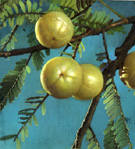| Latin Names | Emblica officinalis Gaertn. syn.Phyllanthus emblica Linn. (Euphorbiaceae) |
| English Names | Indian gooseberry, Emblic myrobalan |
| Sanskrit Names | Amalaki, Dhatriphala |
| Hindi Names | Amla, Aovla |
 Distribution: The tree is common in the mixed deciduous forests of India ascending to 4,500 ft. on the hills. Habit: E.a. is a small or medium-sized deciduous tree with smooth, greenish grey, exfoliating bark. The leaves are feathery with small narrowly oblong, pinnately arranged leaflets. The fruits are depressed, globose, fleshy and obscurely 6-lobed, containing 6 trigonous seeds. Principle constituents: Vitamin C Indications: The fruit is acrid, cooling, refrigerant, diuretic and laxative. The dried fruit is useful in hemorrhage, diarrhea and dysentery. In combination with iron, it is used as a remedy for anemia, jaundice and dyspepsia. Amla fruits are anabolic, anti-bacterial and resistance building. They possess expectorant, cardiotonic, antipyretic, antioxidative, antiviral and anti-emetic activities. They are also used in the treatment of leukorrhea and atherosclerosis. Product range: Abana, Bonnisan, Mentat, Pilex, Septilin, Styplon, Menotab, Ophthacare, Gasex, Lukol, V-Gel, Vegecort. |
|